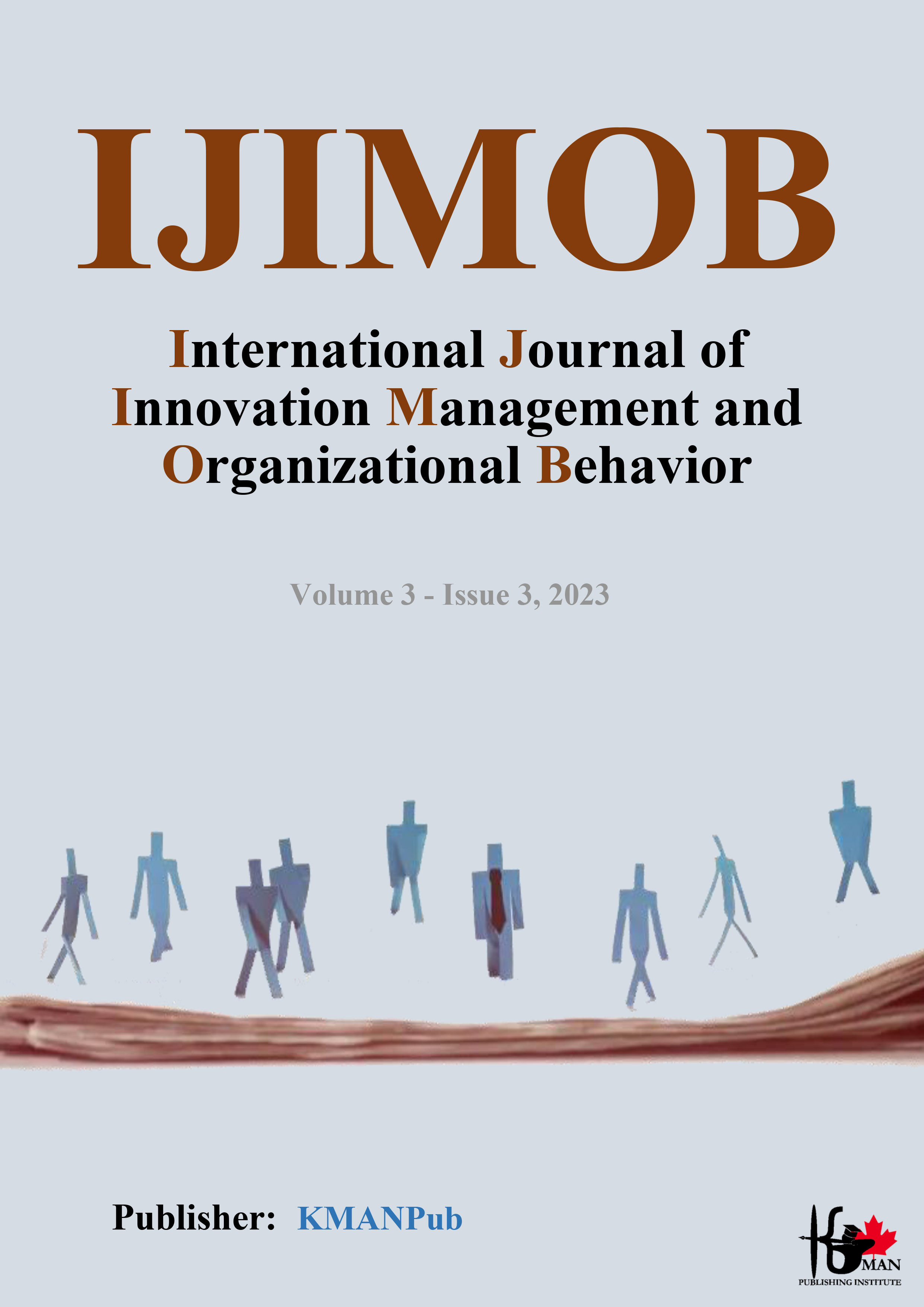Developing and Presenting a Shadow Leadership Model in the Ministry of Water Resources of Iraq
Keywords:
Shadow leadership, informal power structures , governance , political influence, Iraq, structural equation modeling , grounded theoryAbstract
Objective: This study aims to develop and present a model of shadow leadership in Iraq’s Ministry of Water Resources by examining its causal conditions, intervening factors, strategies, and consequences.
Methods and Materials: The study employs a mixed-methods approach, integrating qualitative and quantitative research. In the qualitative phase, 18 experts, including university faculty members specializing in behavioral sciences and water resource professionals, were selected through purposive sampling for in-depth interviews. The qualitative data were analyzed using grounded theory, including open, axial, and selective coding. In the quantitative phase, 384 employees of the Ministry of Water Resources were surveyed using a researcher-designed questionnaire based on qualitative findings. The questionnaire’s validity was assessed using the Content Validity Ratio (CVR), and its reliability was confirmed with a Cronbach’s alpha of 0.858. Data analysis involved structural equation modeling (SEM) to test the proposed model.
Findings: The results indicate that shadow leadership in Iraq’s Ministry of Water Resources is shaped by political, social, and institutional factors. Causal conditions include power challenges, shadow power requirements, social challenges, environmental instability, and governmental shortcomings. Contextual conditions such as networked power, ideological influence, and media control reinforce shadow leadership mechanisms. Intervening factors, including critics’ management, stakeholder expectations, and political identity, shape strategic actions. Identified strategies encompass social development, professional development, media transformation, and fear-based cultural tactics. The consequences highlight both stabilizing effects, such as leadership efficiency and interaction development, and challenges, such as political control and reduced transparency.
Conclusion: Shadow leadership operates as an alternative mechanism of influence in bureaucratic institutions, particularly where formal leadership structures are constrained by political and governance challenges. While it can stabilize decision-making, it also poses risks to transparency and accountability. Strengthening formal governance mechanisms, fostering ethical leadership, and increasing participatory decision-making can mitigate the adverse effects of shadow leadership while leveraging its stabilizing role.
Keywords: Shadow leadership, informal power structures, governance, political influence, Iraq, structural equation modeling, grounded theory.
Downloads
References
Alho, P. (2020). A Jungian Theory of Mind: Individuality, lost, gained, and transcended. https://www.doria.fi/bitstream/handle/10024/177125/alho_paivi.pdf
Ali Mohammadi, S., Salehi, M., Ahmadi, E., & Amirian Zadeh, M. (2021). Development and Evaluation of an Ethical Leadership Model in the Fars Province Education Organization: A Mixed Approach. Journal of Management in Educational Organizations, 10(2), 13-50. https://journalieaa.ir/article-1-217-en.html
Allen, C. (2020). Carl Jung. https://doi.org/10.15760/pdxopen-25
Avolio, B. J., Keng-Highberger, F. T., Lord, R. G., Hannah, S. T., Schaubroeck, J. M., & Kozlowski, S. W. (2022). How leader and follower prototypical and antitypical attributes influence ratings of transformational leadership in an extreme context. Human Relations, 75(3), 441-474. https://doi.org/10.1177/0018726720958040
Bandeh Moradi, S., & Zangoei Pour Motlaq, Z. (2022). Meta-Synthesis of the Role of Ethical Leadership in Education. Applied Educational Leadership. https://pbeo.uma.ac.ir/article_2498.html?lang=en
Bullemore Campbell, J. (2024). Unveiling the Shadow: Theorizing the Impact of Narcissistic Leadership on Sales Teams. International Review of Management and Marketing. https://doi.org/10.32479/irmm.15991
Chappell, S., Cooper, E., & Trippe, G. (2019). Shadow work for leadership development. Journal of Management Development, 38(5), 326-335. https://doi.org/10.1108/JMD-08-2018-0216
Cunliffe, R. (2023). The Tories are split into three camps and a shadow leadership contest is under way. New Statesman, 152(5746), 19-20. https://www.newstatesman.com/politics/uk-politics/2023/12/the-tories-are-split-into-three-camps-and-a-shadow-leadership-contest-is-under-way
de Haan, E. (2016). The leadership shadow: How to recognise and avoid derailment, hubris and overdrive. Leadership, 12(4), 504-512. https://doi.org/10.1177/1742715015572526
Dehdast, N. (2022). Examination and Identification of Power Components in Organizations (With an Emphasis on Leadership Power). Afaq-e Oloum-e Ensani (Horizons of Human Sciences), 62(6), 1-17. https://en.civilica.com/doc/1879942/
Evans, M., & Jovanović, M. (2016). Shadow leadership. In The Palgrave Handbook of Global Political Psychology (pp. 275-293). Palgrave Macmillan, London.
Freysson, E. (2020). The hidden side of the soul: how the shadow archetype relates to human evil https://skemman.is/bitstream/1946/37608/1/The%20Hidden%20Side%20of%20the%20Soul%20-%20Eli%20Freysson.pdf
Gamil, T., Fanos, N., & Ameen, M. (2022). The Role of Ethical Leadership in the Work Environment to Empower Workers by Applying to Private Institutes of the Ministry of Higher Education. Journal of Environmental Science, 51(12), 19-34. https://jes.journals.ekb.eg/article_301572.html
Hallinger, P. (2018). Bringing context out of the shadows of leadership. Educational Management Administration & Leadership, 46(1), 5-24. https://doi.org/10.1177/1741143216670652
Mahmoud, A. N. (2023). The Impact of Ethical Leadership on Educational Excellence Among Kindergarten Teachers in Public Schools Affiliated with the Ministry of Education in Jordan. Dirasat: Educational Sciences, 50(2), 1-18. https://doi.org/10.35516/edu.v50i2.4686
Noori, S. R., Malekzadeh, G., Rahimnia, F., & Khorakian, A. (2023). Explanation of Ethical Leadership Components in the Defense Industries Organization of the Islamic Republic of Iran: A Qualitative Approach. Public Management Research, 16(59), 31-58. https://jmr.usb.ac.ir/article_7681.html?lang=en
Perry, C., & Tower, R. E. (2023). Jung's Shadow Concept: The Hidden Light and Darkness Within Ourselves. https://doi.org/10.4324/9781003255819
Rangriz, H., & Khamehchi, H. (2021). Meta-Analysis of the Consequences of Ethical Leadership. Ethics in Science and Technology, 17(2), 51-55. https://ethicsjournal.ir/article-1-2666-en.html
Rezaeian, A., Abedi-Jafari, H., Lotfi, A., & Yousefi, M. (2022). Typology of Power and Mechanisms of Leader Influence from the Perspective of the Quran. Quran and Science Studies, 12(6), 8-40. https://journals.miu.ac.ir/article_7926.html?lang=en
Soltani-Fard, A. R., Mohammaddavoodi, A. H., & Qorchiian, N. (2023). Presenting a Model for Enhancing Ethical Leadership in the Central Management of the Ministry of Education. Educational Leadership and Management, 17(1), 30-57. https://journals.iau.ir/article_701995.html
Steinecke, D. (2022). Shadows as leaders? The amendment success of shadow rapporteurs in the European Parliament. European Union Politics, 23(4), 700-720. https://doi.org/10.1177/14651165221121739
Walker, S., & Watkins, D. (2020). Shadows of leadership: The lived experiences of oppressed followers of toxic leaders. Journal of Leadership, Accountability and Ethics, 17(2). https://doi.org/10.33423/jlae.v17i2.2872
Zwingmann, I., Wolf, S., & Richter, P. (2016). Every light has its shadow: A longitudinal study of transformational leadership and leaders' emotional exhaustion. Journal of Applied Social Psychology, 46(1), 19-33. https://doi.org/10.1111/jasp.12352

Downloads
Additional Files
Published
Submitted
Revised
Accepted
Issue
Section
License
Copyright (c) 2025 Hayder Abdulrahman Khamas (Author); Mohammad Reza Dalvi (Corresponding Author); Zaki Muhammad Abbas, Mehrdad Sadeghi (Author)

This work is licensed under a Creative Commons Attribution-NonCommercial 4.0 International License.















